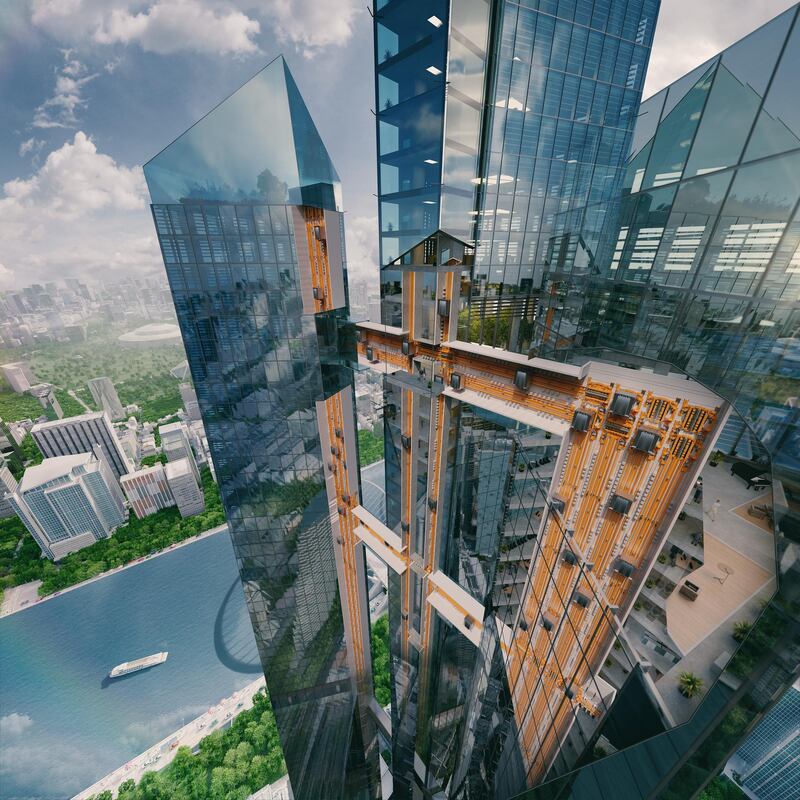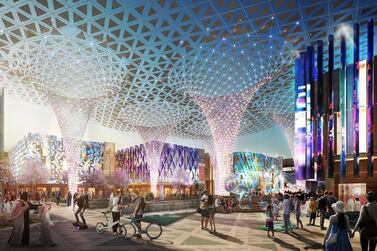A ropeless lift that can travel horizontally and vertically – though perhaps not as dramatically as the Great Glass Elevator described in Charlie and the Chocolate Factory – will be presented at Expo 2020.
Previously thought to be the stuff of Hollywood films, the Multi lift will be a key attraction at the German Pavilion in Dubai.
Instead of using ropes, the Multi cabins are powered by magnetic technology.
Thyssenkrupp Elevator, the company behind the project, said it was more akin to a metro station inside a building than a traditional lift system.
"Dubai is both a significant global business hub and a tourist destination. It's a city that provides a platform for new inventions, attracting people and businesses from across the world," Peter Walker, chief executive of thyssenkrupp Elevator, said.
”Multi will support this aim, demonstrating to those at Expo 2020 precisely how technology can support the growth of urban mobility.”
The Multi lift was revealed to the public in 2017 at the thyssenkrupp test tower in Rottweil, Germany.
Thyssenkrupp said that removing ropes traditionally used to raise and lower the cabin meant more than one could be placed in a shaft at a time, reducing the time people are made to wait for a lift.
The company said placing several cabins in a shaft at one time would also significantly reduce the amount of energy each building used once the Multi lifts were installed.
The magnetic technology, known as maglev, is similar to that used in high-speed trains in Japan and Germany.
It gives the impression of the lifts are floating because it does not involve moving parts, creating a smoother ride than traditional lifts.
The magnetised Multi system also means there will be no maintenance issues caused by rope sway.
Two sets of magnets are used, one to repel the cabin from the shaft and the other to move it along.
Thyssenkrupp said it wanted the Multi cabin to transform the way people travel within buildings.
The company also said that, because the cabins required fewer and smaller shafts than conventional lifts, it would reduce a building's elevator footprint by up to 50 per cent.
This would be a major boost because in many cases a lift can take up to 40 per cent of a building's floor space.
By using linear motors for each individual cabin, no chain is needed to control the lift. The cabins can even move on inclines if needed.
The technology can also be used to shuttle someone from one building to another, thyssenkrupp said.
Each cabin moves with a top speed of about six metres per second and requires significantly less peak power, as much as a 70 per cent less than conventional lift systems.
A thyssenkrupp spokesman said the technology also had applications beyond the Multi lift.
“Multi will demonstrate how various transportation solutions, from underground logistics to air taxis, can be interconnected with the ropeless elevator,” he said.
"Skybridges powered by horizontally moving Multi will support lifting passenger transportation to a whole new level."
He said there was a need for such transportation in skyscrapers, because there were 63 cities with more than three million inhabitants. That was only going to increase, he said.
“Since 2000, the number of high-rise buildings more than 200 metres in height has tripled,” he said.
The magnetised system also means there will be no maintenance issues caused by rope sway.








